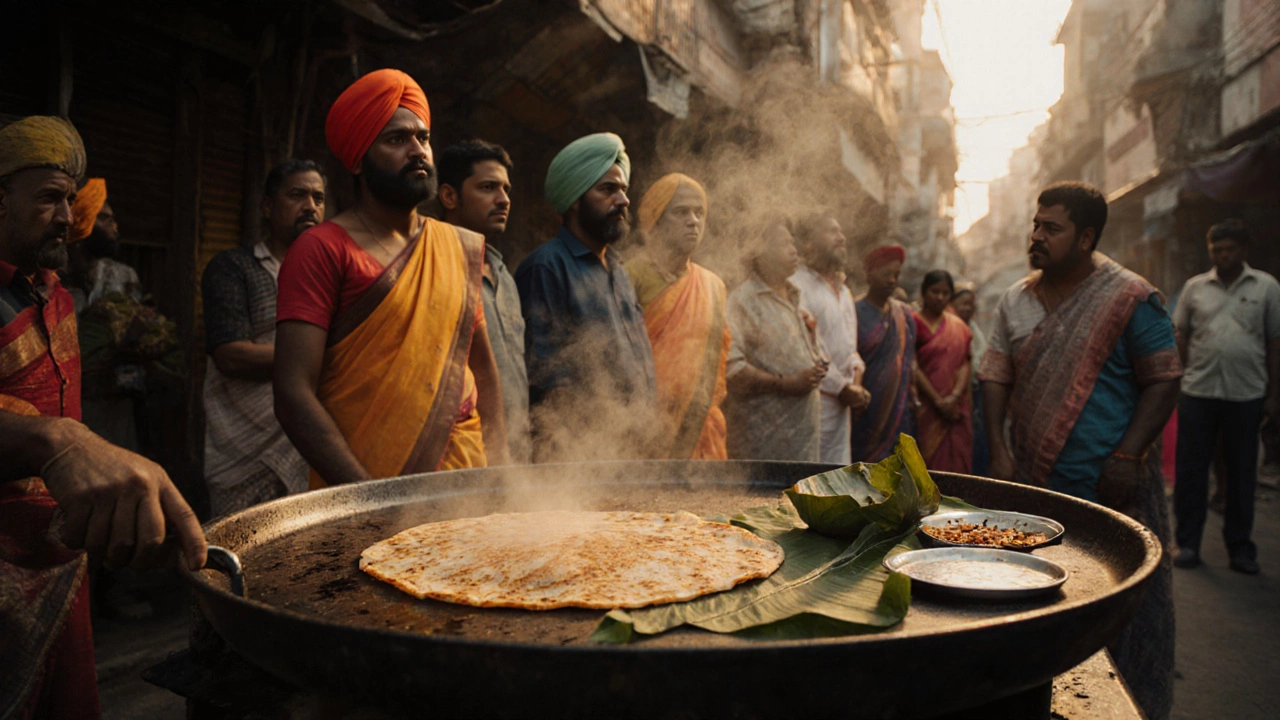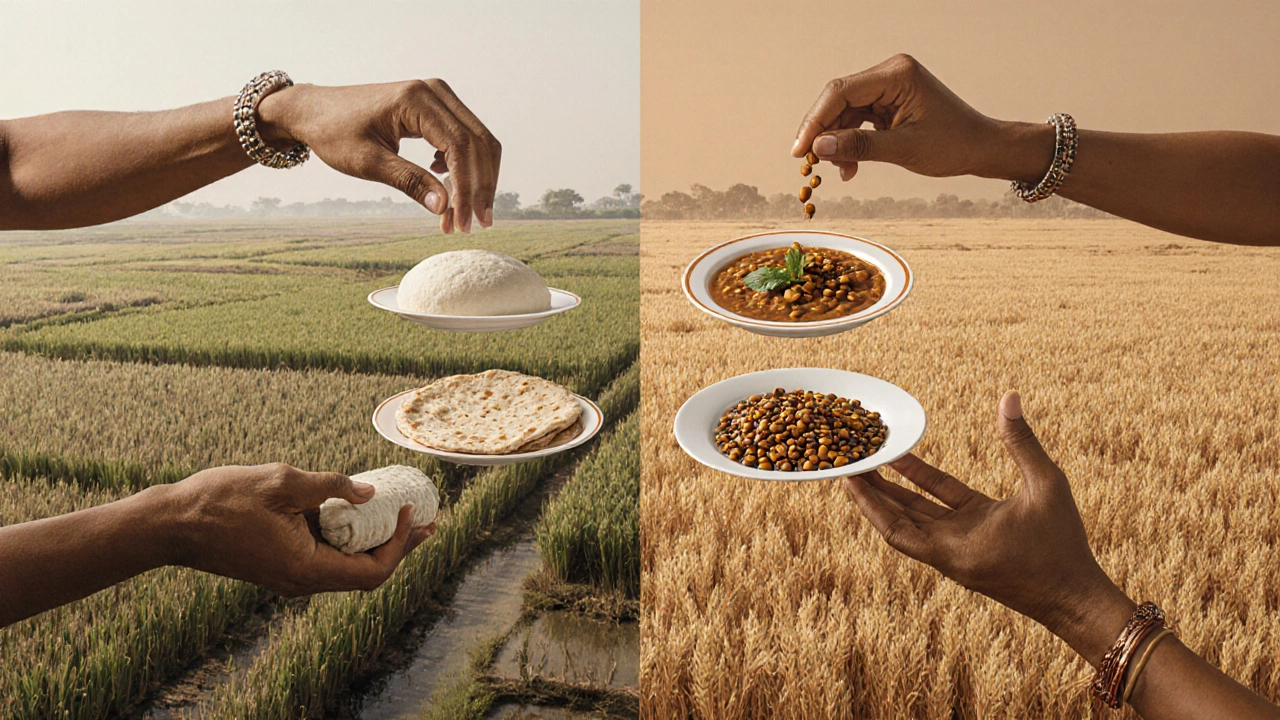Indian Food Preference Calculator
This tool shows you the most common daily foods based on India's regional food patterns. Select your state or region to see what's eaten daily where you live.
Your Daily Food Pattern
Staple Foods
Select a region to see your daily staples
Breakfast
Select a region to see your morning meal
Why This Matters
Select a region to see why this food is common
Ask anyone in India what they eat every day, and the answer won’t be fancy curries or restaurant dishes. It’ll be something simple, warm, and always ready by 7 a.m. The truth? India doesn’t eat one single dish the most-it eats a rhythm. A daily cycle of carbs, spices, and comfort that changes with the region but stays the same in spirit.
Roti and rice: the two pillars of every Indian meal
If you had to pick the two most eaten foods in India, they’d be roti and rice. Not as separate choices, but as partners in a daily dance. In the north, roti-made from whole wheat flour, water, and salt-is the default. It’s rolled by hand, cooked on a tawa, and used to scoop up dal, sabzi, or yogurt. A family of four might go through 12-15 rotis in one meal. In the south, rice takes over. Steamed, fluffy, and served with sambar or coconut chutney, it’s eaten three times a day in states like Tamil Nadu, Kerala, and Andhra Pradesh.
According to India’s National Family Health Survey, over 80% of households in rural areas and 65% in urban areas eat rice or wheat-based staples at least twice a day. That’s not a trend-it’s a survival habit. These aren’t luxury foods. They’re the foundation. You don’t eat roti because it’s trendy. You eat it because it fills you up, lasts all morning, and costs less than a rupee per piece.
Breakfast isn’t a meal-it’s a ritual
When people ask what India eats the most, they’re often thinking of breakfast. And that’s where the real answer hides. In Delhi, it’s parathas stuffed with potato or paneer, eaten with pickle and yogurt. In Bengal, it’s puchka-crispy shells filled with tamarind water and chickpeas-sold on street corners before 8 a.m. In Maharashtra, vada pav is the go-to: a spicy potato fritter in a bun, dipped in chutney. In Karnataka, it’s upma-semolina cooked with mustard seeds, curry leaves, and peanuts.
But the undisputed king of Indian breakfasts? Dosa. Not the fancy, restaurant version with cheese and mayo. The real one: thin, crispy, fermented rice-and-lentil batter cooked on a hot griddle, served with coconut chutney and sambar. It’s eaten from Kerala to Kashmir, from villages to high-rises. Over 200 million dosas are made in India every day. That’s more than the population of Brazil. You’ll see grandmas making them at 5 a.m., college students grabbing them before class, and office workers eating them with coffee at 7:30.
Why these foods? It’s not about taste-it’s about access
India doesn’t eat what’s popular. It eats what’s available. Rice grows in wetlands from Assam to Odisha. Wheat thrives in the dry plains of Punjab and Haryana. Lentils? They’re cheap, protein-rich, and grow in almost every soil. That’s why dal-lentil stew-is on the table in every home, every day. It’s not a side dish. It’s the main event. Yellow dal with ghee, salt, and a pinch of turmeric is the most common meal in rural India.
Street food isn’t just for snacks. It’s for survival. In Mumbai, 60% of daily wage workers eat vada pav or pav bhaji for breakfast. In Jaipur, it’s kachori with chana masala. These foods are fast, cheap, and filling. A vada pav costs 25 rupees (under 30 cents). A plate of rice with dal and vegetables? 40 rupees. You can’t feed a family of five on McDonald’s. But you can on roti and dal.

What’s missing? Meat, dairy, and sugar
Most people assume India eats a lot of meat. It doesn’t. Less than 20% of Indians eat meat daily. Vegetarianism isn’t just cultural-it’s economic. Chicken and eggs are common in cities, but beef? Almost nonexistent. Pork? Rare outside the northeast.
Dairy is everywhere, but not as a main dish. Milk is drunk in the morning. Curd is eaten with rice. Ghee is drizzled on roti. Paneer? Used in curries, but not daily. Sugar? Minimal. Traditional meals don’t rely on sweeteners. Jaggery shows up in snacks, but not in breakfast bowls. The sweetness comes from fruit-bananas, mangoes, guavas-eaten fresh.
The real daily diet: a breakdown
Here’s what an average Indian eats in one day, based on data from the Indian Council of Medical Research:
- Breakfast: 1-2 rotis or 1 cup rice + dal + chutney or pickle
- Lunch: 2-3 rotis or 1.5 cups rice + 1 cup dal + 1/2 cup vegetable curry + yogurt
- Dinner: Lighter-often leftover rice or roti with dal or sautéed greens
- Snacks: Roasted chickpeas, boiled potatoes, or a small bowl of fruit
No pasta. No sandwiches. No cereal. No toast. No protein shakes. Just food that grows nearby, cooks fast, and keeps you going until the next meal.

Why this matters beyond the plate
What India eats the most isn’t about flavor. It’s about resilience. These foods are designed for heat, for labor, for poverty, for tradition. They don’t need refrigeration. They don’t need fancy tools. They’re made with one pot, one flame, and hands that have done this a thousand times before.
When you see a woman in a village rolling roti at sunrise, she’s not cooking for Instagram. She’s feeding her children. When a man in Chennai buys a plate of idli and sambar for 30 rupees, he’s not choosing a trend-he’s choosing survival. And when millions do it every single day, it becomes the most eaten food in India: not a dish, but a system.
So if you want to know what India eats the most? Look past the viral videos of biryani and butter chicken. Look at the street vendor with the dosa batter, the grandmother with the tawa, the child eating rice with lentils while waiting for the school bus. That’s the real India. And that’s what’s on the table every day.
What is the most common breakfast food in India?
The most common breakfast food in India is dosa, especially in the south, and roti with dal or sabzi in the north. Dosa is eaten daily by over 200 million people, while roti-based breakfasts dominate in states like Uttar Pradesh, Rajasthan, and Punjab. Both are affordable, easy to make, and filling.
Do Indians eat rice or roti more often?
It depends on the region. Rice is the staple in southern and eastern India-states like Tamil Nadu, West Bengal, and Odisha. Roti (wheat flatbread) is dominant in the north and west-Punjab, Haryana, Gujarat, and Rajasthan. Nationally, both are eaten daily by over 80% of households, but rice consumption is higher in total volume because of population density in rice-growing areas.
Is Indian food mostly vegetarian?
Yes, the majority of Indian meals are vegetarian. Around 38% of Indians are vegetarian, and even many non-vegetarians eat meat only once or twice a week. Daily meals center on lentils, rice, roti, vegetables, and dairy. Meat is often reserved for special occasions or weekends.
Why don’t Indians eat bread like Western countries?
Western-style bread is expensive, requires ovens, and doesn’t keep well in India’s heat. Roti is made fresh daily on a tawa for under 50 paise per piece. It’s more filling, pairs better with curries, and fits the traditional cooking method. Bread exists in cities, but it’s a luxury, not a staple.
What’s the cheapest daily food in India?
The cheapest daily food is dal (lentils) with rice or roti. A plate of rice and yellow dal costs about 30-40 rupees ($0.35-$0.50) in most towns. In rural areas, families grow their own lentils and grains, making the cost nearly zero. This combo provides protein, carbs, and energy for under 10 rupees per person per meal.
What to try next
If you want to understand Indian food, don’t start with curry powder or tikka masala. Start with a bowl of rice and dal. Make a simple dosa. Eat roti with just ghee and salt. Taste the way India actually eats-not the way it’s marketed. That’s where the real flavor lives.
